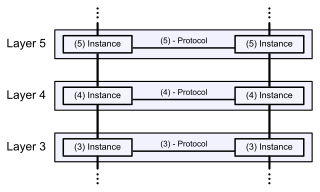The Internet Protocol (IP) is the principal communications protocol in the Internet protocol suite for relaying datagrams across network boundaries. Its routing function enables internetworking, and essentially establishes the Internet.
The Internet protocol suite is the conceptual model and set of communications protocols used in the Internet and similar computer networks. It is commonly known as TCP/IP because the foundational protocols in the suite are the Transmission Control Protocol (TCP) and the Internet Protocol (IP). During its development, versions of it were known as the Department of Defense (DoD) model because the development of the networking method was funded by the United States Department of Defense through DARPA.

The Open Systems Interconnection model is a conceptual model that characterizes and standardizes the communication functions of a telecommunication or computing system without regard to its underlying internal structure and technology. Its goal is the interoperability of diverse communication systems with standard communication protocols. The model partitions a communication system into abstraction layers. The original version of the model had seven layers.
In the seven-layer OSI model of computer networking, the network layer is layer 3. The network layer is responsible for packet forwarding including routing through intermediate routers.
In the seven-layer OSI model of computer networking, the session layer is layer 5.
In the IEEE 802 reference model of computer networking, the logical link control (LLC) data communication protocol layer is the upper sublayer of the data link layer of the seven-layer OSI model. The LLC sublayer acts as an interface between the media access control (MAC) sublayer and the network layer.
An application layer is an abstraction layer that specifies the shared communications protocols and interface methods used by hosts in a communications network. The application layer abstraction is used in both of the standard models of computer networking: the Internet Protocol Suite (TCP/IP) and the OSI model. Although both models use the same term for their respective highest level layer, the detailed definitions and purposes are different.
FCAPS is the ISO Telecommunications Management Network model and framework for network management. FCAPS is an acronym for fault, configuration, accounting, performance, security, the management categories into which the ISO model defines network management tasks. In non-billing organizations accounting is sometimes replaced with administration.
A management information base (MIB) is a database used for managing the entities in a communication network. Most often associated with the Simple Network Management Protocol (SNMP), the term is also used more generically in contexts such as in OSI/ISO Network management model. While intended to refer to the complete collection of management information available on an entity, it is often used to refer to a particular subset, more correctly referred to as MIB-module.
FTAM, ISO standard 8571, is the OSI application layer protocol for file transfer, access and management.
IEEE 802.10 is a former standard for security functions that could be used in both local area networks and metropolitan area networks based on IEEE 802 protocols.

The Network Configuration Protocol (NETCONF) is a network management protocol developed and standardized by the IETF. It was developed in the NETCONF working group and published in December 2006 as RFC 4741 and later revised in June 2011 and published as RFC 6241. The NETCONF protocol specification is an Internet Standards Track document.
The internet layer is a group of internetworking methods, protocols, and specifications in the Internet protocol suite that are used to transport network packets from the originating host across network boundaries, if necessary, to the destination host specified by an IP address. The internet layer derives its name from its function facilitating internetworking, which is the concept of connecting multiple networks with each other through gateways.

A storage area network (SAN) or storage network is a computer network which provides access to consolidated, block-level data storage. SANs are primarily used to enhance accessibility of storage devices, such as disk arrays and tape libraries, to servers so that the devices appear to the operating system as locally-attached devices. A SAN typically is a dedicated network of storage devices not accessible through the local area network (LAN) by other devices, thereby preventing interference of LAN traffic in data transfer.
YANG is a data modeling language for the definition of data sent over network management protocols such as the NETCONF and RESTCONF. The YANG data modeling language is maintained by the NETMOD working group in the Internet Engineering Task Force (IETF) and was published as RFC 6020 in October 2010. The data modeling language can be used to model both configuration data as well as state data of network elements. Furthermore, YANG can be used to define the format of event notifications emitted by network elements and it allows data modelers to define the signature of remote procedure calls that can be invoked on network elements via the NETCONF protocol. The language, being protocol independent, can then be converted into any encoding format, e.g. XML or JSON, that the network configuration protocol supports.
In telecommunication, a communication protocol is a system of rules that allow two or more entities of a communications system to transmit information via any kind of variation of a physical quantity. The protocol defines the rules, syntax, semantics and synchronization of communication and possible error recovery methods. Protocols may be implemented by hardware, software, or a combination of both.
Operations Support Systems (OSS), or Operational Support Systems in British usage, are computer systems used by telecommunications service providers to manage their networks. They support management functions such as network inventory, service provisioning, network configuration and fault management.
Cloud Infrastructure Management Interface (CIMI) is an open standard API specification for managing cloud infrastructure.
This page is based on this
Wikipedia article Text is available under the
CC BY-SA 4.0 license; additional terms may apply.
Images, videos and audio are available under their respective licenses.


